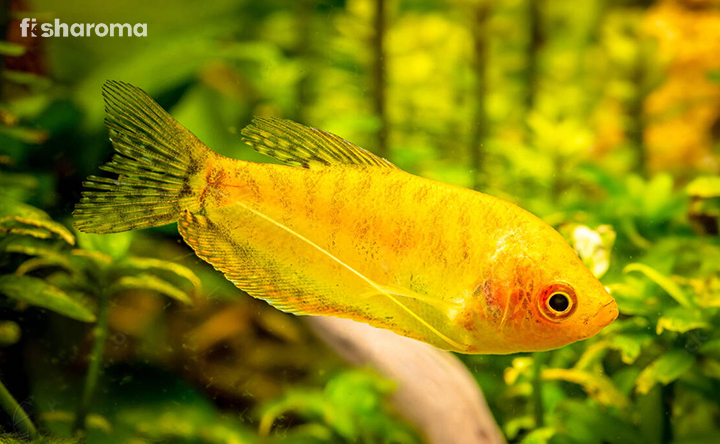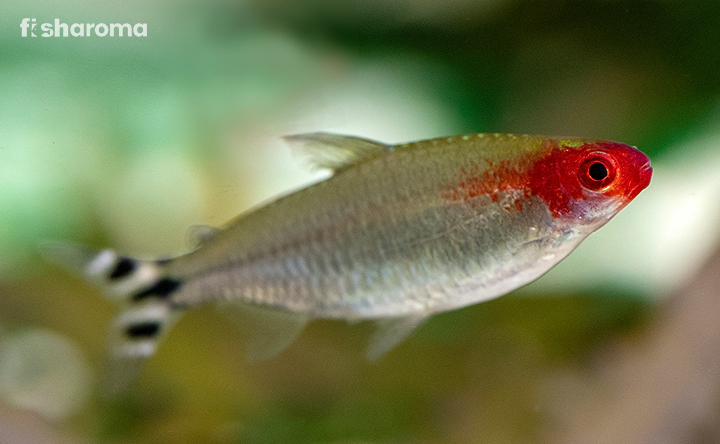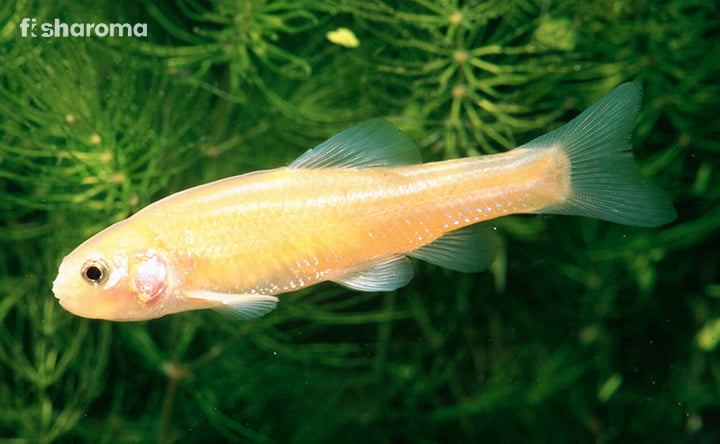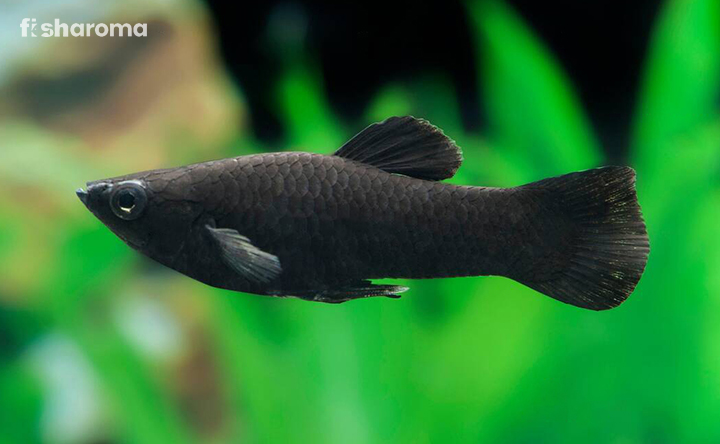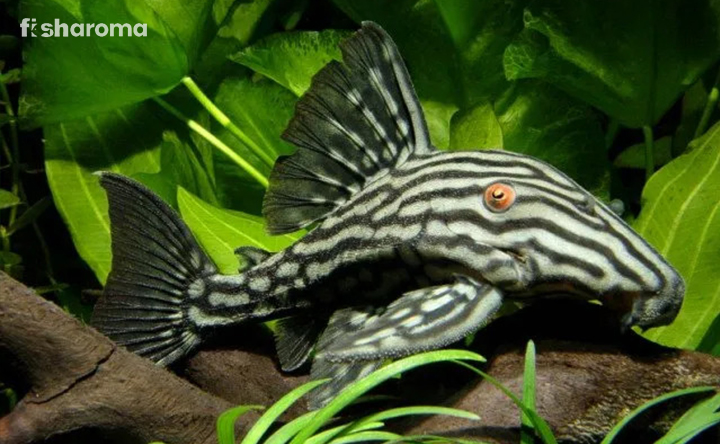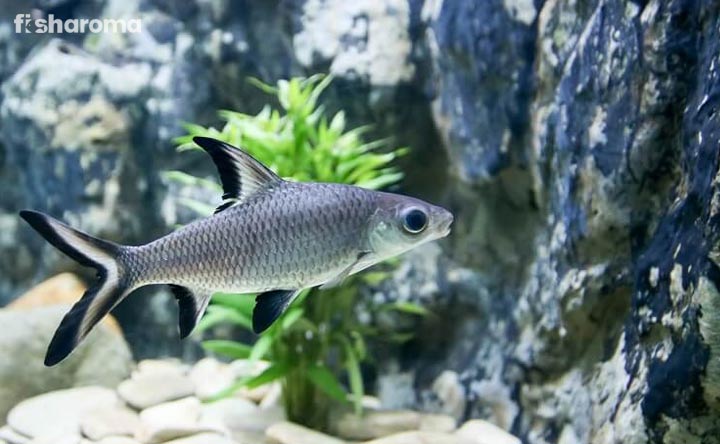Bolivian Ram Complete Care Guide – The Highly Compatible Pet for Community Tanks

Known for their intriguing behaviors and striking appearance, Bolivian Rams are admired by fishkeepers across the globe. What works in their favor is the fact that they are an ideal candidate for community tanks owing to their social and highly compatible nature, which is so unlike the other members of the family that this fish belongs to. Their non-demanding care level makes them an easy choice for any aquarist. So, what are you waiting for? Let’s get to know them better.
Key Specifications of Bolivian Ram
Before you get to know about the life of a Bolivian Ram in detail, take a sneak-peek into its key specifications from this table.
| Scientific Name | Mikrogeophagus altispinosus |
| Family | Cichlidae |
| Origin | South America |
| Size | 3.5” (8.8 cm) |
| Color | Dull brown to greyish-blue body with tinges of other colors all around |
| Care Level | Easy |
| Lifespan | 4 Years |
| Temperament | Peaceful |
| Compatibility | Moderate |
| Tank Size | 30-Gallons |
| Diet | Omnivore |
Overview
Belonging to the family of Cichlidae, Bolivian Rams are a small, peaceful species that were first described in the year 1911. They were originally named Crenicara altispinosa. However, in 1977, their scientific name was changed to Paplilochromis altispinosus before finally being again changed to Mikrogeophagus altispinosus, which they are currently known as.
They are also known by many common names such as Butterfly Ram, Bolivian Butterfly, Red Cichlid, Ruby Clown Cichlid, Ruby Clown Cichlid, and Bolivian Butterfly Cichlid.
Origin & Habitat of Bolivian Ram
Bolivian Rams have their roots in the South American countries of Bolivia (as their name suggests) and Brazil. In fact, they are named as Bolivian Ram because the first-ever catalogued specimen was collected from a shallow pond in Bolivia.
They are also seen in the Guarpore Basin at San Ramone, the Rio Mamore near the mouth of the Rio Guarpore River at Trinidad, Flood plains below Todos Santos, and near the mouth of the Igarape River at Guarjara-Mirim.
As far as their habitat is concerned, they are mostly seen in river tributaries, lakes, backwaters, lagoons, pools, and streams that have a muddy or sandy substrate, thick vegetation and an abundance of roots, snags, and branches that offer these majestic species shaded areas and hiding spots. They mostly inhabit the mid and bottom areas of slow-moving water.
Appearance of Bolivian Ram
Bolivian Rams have an elongated oval-shaped body with pointed spiky ray-shaped fins and a tail. These spiky rays protect them from predators. They are known to strangle and suffocate their predators with the help of these rays.
Speaking of sexual dimorphism, it is pretty easy to distinguish the males from the females. The males are usually larger than their female counterparts and their dorsal fins are also more pointed than them. In addition, males have longer filaments along their tail.
The frontal part of the fins of Bolivian Rams is soft, thereby allowing them to maintain precise positions and effortless movements that contribute to a graceful swim rather than a fast swim.
Similar to other members of the Cichlid family, they also have one nostril on both sides. They “smell” water by sucking the water and expelling it back after “sampling” it for a period of time. Besides, just like all other Cichlids, Bolivian Rams also have a well-developed pharyngeal set of teeth in their throat, along with a regular set of teeth.
Size of Bolivian Ram
Bolivian Rams are small freshwater fish wherein the males grow up to 3.5” (8.8 cm) and the females grow up to 2.5” (6.3 cm).
Color of Bolivian Ram
The body of a Bolivian Ram ranges from dull brown to greyish blue. Their bellies are primarily in yellow color that extends almost to their frontal portion.
Males have a distinct black spot in the middle of their body while females have two such spots. Some variants even sport a crescent vertical black line between their eyes. Their tall dorsal fin is predominantly transparent. The edges of their dorsal, anal, and pectoral fins, as well as their tail, are orange in color.
Behavior of Bolivian Ram
Peaceful by nature, they are known for their intelligent and friendly demeanor. Although belonging to the family of Cichlids does install a bit of aggression in them, but their idea of aggression is on the lines of ‘more bark than bite’. So, compared to their other Cichlid cousins, they are pretty tamed.
This mid and bottom-dwelling species displays a unique swimming pattern, wherein they move for a few strokes before suddenly stopping, and continuing this over and over. They mostly do this at the time of feeding in order to sieve through the substrate while not stirring it up.
However, in order to escape predators, they can switch their graceful swimming with fast swimming as well.
Lifespan of Bolivian Ram
The average lifespan of a Bolivian Ram is four years.
Diet of Bolivian Ram
Feeding these omnivores is actually very convenient since they are not fussy-eaters at all and would consume most food that you provide them. In their natural habitat, they mainly consume small invertebrates, riverbed detritus, seeds, and other plant matters.
As we have mentioned above, they are often seen sifting through the substrate in search of their food. This is a behavior that you would notice both in wild and in captivity. They take in a mouthful of substrate, and expel it through their gills or mouth, after “sampling” it in search of food.
In an aquarium setting, they are open to live food, frozen food, flakes, as well as pellets. We recommend feeding them more pellets than flakes owing to the fact that Bolivian Rams spend more time at the mid and bottom portion of the tank. Pellets are more likely to sink to the substrate than flakes. An ideal diet of Bolivian Ram should consist of the following items:
- Bloodworms (Frozen and live)
- Brine Shrimps (Frozen and live)
- White Worms (Frozen and live)
- Chopped Earthworms
- Cyclopeeze
- Daphnia
- Tubifex
- Blanched vegetables
Coming to artificial foods, the Hikari Tropical Micro Pellet Fish Food is a great option for them. As far as the number of times you need to feed them, the ideal number is 2-3 times in small portions. Interestingly, a large portion of food once a day has more chances of deteriorating the quality of the tank water than several small portions of food throughout the day.
Tank Requirements for Bolivian Ram
Please bear in mind the following aspects while building an ideal home for your Bolivian Rams.
Tank Size
Bolivian Rams should be kept in groups. This is why you would need a medium-sized tank of 30 gallons for them, despite their small individual size. This tank size is sufficient to house six of them together. With each additional Bolivian Ram that you add, don’t forget to add in an extra space of 5-10 gallons
Substrate
As we have stated above that these freshwater species spend a considerable amount of their time sifting through the substrate in search of food, you need to ensure that the substrate you provide in their tank is soft and non-sharp. Therefore, go for fine sand with few pebbles here and there. You need to make sure that the pebbles are not too small since these fish might accidentally ingest them.
Filter
In the wild, they live in slow-moving water. Therefore, you need to pick a filter that provides a perfect balance between maintaining minimal water flow and filtration. A hang-on filter works for them.
Nature of Lighting
Their natural habitat is heavily shaded. Thus, maintain a subdued lighting system in their tank.
Presence of Flora
Plants play a significant role in their lives. From providing food to blocking excess light as well as act as hidings spots and shelters, they do it all. Since Bolivian Rams prefer slightly acidic water, you need to ensure that the plants that you keep in their tank should also be able to survive in them. Ideal aquatic plants that you can raise in a Bolivian Ram tank are as follows:
- Water Wisteria
- Amazon Sword Plant
- Java Fern
- Java Moss
- Anubias Nana
- Vallisneria
Java Moss helps in lowering the pH level of the water, which works well for Bolivian Rams.
Ornaments
Feel free to provide plenty of hiding spots for them in the form of branches, driftwood, aquatic caves, rocks, among others. At the same time, please make sure that you don’t block their space of swimming. In addition, these ornaments shouldn’t have any sharp edges to them. When using pipes and caves, ensure that their openings are large enough for these fish to slip in and out.
Driftwood helps in lowering the pH level and in bringing a ‘tea-stained’ color to the water, which is great for Bolivian Rams.
Cleaning Method
Maintaining a medium or large tank is comparatively easier than a small tank since water tends to be more stable in them, thereby giving more room for errors to aquarists.
You should put all the ornaments and substrate under running tap water to clean them. You may also vacuum the substrate to thoroughly get rid of the waste products. In addition, clean all viewing panes of algae and wipe off the interior walls with a soft cloth dipped in lukewarm water. Soap-based or chemical-based products are to be avoided since their residues are harmful to the health of your Bolivian Rams.
This cleaning process should be done at least once a month.
Besides, the major thing about cleaning is that you should always follow quarantining rules. Anything you add to your tank, be it a new species or an ornament or even the substrate, has to be quarantined since you never know what may bring an infection.
Water Type for Bolivian Ram
Tap water seems fine for these fish as long as it doesn’t have an outstanding presence of iron and chlorine. In that case, use filtered water in their tank. The parameters of water that you need to maintain have been listed below.
Temperature
The ideal temperature of tank water for Bolivian Rams is 74-78.0° F (23.3-25.6° C). Use a submerged thermometer to keep a track of the temperature round the clock.
pH Level
The level of pH that you need to maintain in your Bolivian Ram tank is 6.0-7.4. Using litmus paper from time to time helps in keeping a check on the pH level of your tank water.
Hardness
The general hardness of the water should be 6-14 dGH.
Mineral Level
Bolivian Rams are sensitive to the level of nitrates. Therefore, ensure the level of nitrate is as low as possible in your tank.
Replacement Procedure
As we have just stated, the level of nitrates needs to be watched. A great way of doing it is by regular water replacement. What you need to do is decide on a time interval at which you will replace your tank water, and stick to it. It can be a week, a fortnight, or even a month. Of course, the percentage of tank water that you replace will change based on the time interval you choose.
The following table shows the percentage of tank water that you need to replace at different time intervals. Remember, you need to PICK ONLY ONE of the following options.
| Time Interval | Percentage of Water that Needs to be Replaced |
| Weekly (Every 7 days) | 10% |
| Fortnightly (Every 14 days) | 25% |
| Monthly (Every 30 days) | 30-40% |
Remember, never replace the entire tank water altogether unless it is contaminated or heavily infected. This is because changing the entire water content kills off the beneficial bacteria as well as disrupts the ecological balance of the tank. In addition, you also need to remember that the new batch of water that you add to your tank should have the same temperature, pH level, hardness, and mineral level as that of the existing batch of water in the tank.
Compatibility of Bolivian Ram
Bolivian Rams can survive alone, in pairs, and in groups. Keeping them in groups is ideal even if they engage in small squabbles and fights. Unless you notice them being highly aggressive with each other or bullying one, which they do by cornering one or overtaking their food, there is no reason for not keeping them in groups.
Males are more likely to fight with each other for hierarchical reasons and can sometimes be seen retrieving their defeat on the females. But overall, they are one of the most peaceful Cichlids.
As we said earlier, they should be kept in groups of at least six. This also helps in their breeding which we will discuss in detail later in the article.
Suitable Tankmates for Bolivian Ram
It is advised that Bolivian Rams are kept with other non-aggressive species that live in soft water, or with other bottom-dwelling, peaceful species. Also, make sure that their tankmates are of similar size to them.
Keeping these in mind, the suitable tankmates for Bolivian Rams are as follows:
- Neon Tetra
- Rummy Nose Tetra
- Emperor Tetra
- Odessa Barb
- Tiger Barb
- Guppy
- Platy
- Minnow
- Corydoras Catfish
- Dwarf Rainbowfish
- Dwarf Gourami
- Bristlenose Pleco
- Silver Dollar
- Ghost Shrimp
- Amano Shrimp
- Bamboo Shrimp
Unsuitable Tankmates for Bolivian Ram
Avoid keeping Bolivian Rams with aggressive species in a community tank since Bolivian Rams would get bullied by them. In addition, keep small species of fish and invertebrates such as Red Cherry Shrimp away from Bolivian Rams since they would be mistaken for food by them.
Breeding of Bolivian Ram
Bolivian Rams become sexually mature at the age of 9-10 months. In the wild, they are open spawners and are known for forming family groups and laying around 100 eggs.
Breeding of Bolivian Ram is a fairly easy process and can be easily done in captivity once you have managed to find a mated pair. This is why it is advised to raise them not individually, but in a group from a juvenile stage in your aquarium since it naturally helps them pair up.
Once you have identified the mated pair, you can start conditioning their environment to encourage spawning. Although it is not mandatory to put the pair in a separate tank, it helps in maintaining the tank conditions required for breeding in a separate tank.
First of all, make sure the tank is at least 50 gallons and has plenty of shelter and hiding spots in the form of wide leaves, caves, large stones, smooth pebbles, snags, among others. The temperature of the water should be 77-82° F (25-27° C), hardness of the water should be 10 dGH, pH level should be 7-7.5, and the lights should be subdued.
You will notice the pair cleaning and prepping the area a number of times for 2-3 days ahead of spawning. Males also create a pit in the substrate to keep their fries after hatching. When the female is ready, she will swim over the spawning site multiple times for laying around 100-200 eggs whereas the male will protect the area (especially in a community tank, out of fear of the eggs being eaten by other fish species).
Next, the male swims over the eggs and fertilize them externally. This will be followed by both the parents fanning the eggs.
Usually, the eggs hatch within 60 hours. Fries start swimming on their own seven days after hatching. The parents help move the fry by carrying them in their mouths to different locations in the tank for the next couple of weeks. They keep them in the pit that they dug before for their safety. You may feed the fries Vinegar Eels or Shrimp Nauplii. After two months, feel free to feed them the food that you feed an adult Bolivian Ram.
If your Bolivian Ram is breeding for the first time, you may notice them eating away their eggs. However, in their second or third try, they’ll learn and stop doing that.
Bolivian Ram Diseases
Bolivian Rams are vulnerable to various diseases, especially when the state of tank water is stale and the level of oxygen is low. Perhaps the most common disease that strikes them is Ich, which is marked by white spots on their bodies, gills, and fins. It can be treated by increasing the temperature of the tank water to 86° F (30° C) for three days. If the disease still persists, take veterinarian help.
In addition, they are also hit by skin flukes and other infections caused by parasites (worms, protozoa, among others), fungus, and bacteria. This is why we stress so much about quarantining anything you put in the tank beforehand. In any case, don’t shy away from taking medical help if you notice your fish behaving weirdly or having odd marks on their bodies.
Needless to say, regular water replacement and cleaning of the tank will help avoid these diseases to a great extent.
Interesting Facts about Bolivian Ram
- Courtship behavior of a male Bolivian Ram includes rapid body movements including moving their heads back and forth.
- Bolivian Rams are known for their ability to identify their owners.
- With around 1,650 species listed under it, the family of Cichlidae is one of the largest vertebrate families in the world.
Summary
Bolivian Rams are one of the most peaceful Cichlids that you can host in your freshwater aquarium. Easy to take care of, they are known for their graceful swimming patterns and splendid appearance. Their presence will definitely give your aquarium a magnificent look. In addition, they are highly compatible and social by nature, have minimal dietary requirements, and are easy to breed. So, what else do you need? Bring these schooling fish home and take the help of this care guide for looking after them healthily.
Care Guides of Other Freshwater Fish
If you are a fan of Cichlids, then these following articles might interest you.
- How to set up a Cichlid Tank? – Learn the systematic way to effectively build up a safe tank for your Cichlids.
- African Cichlid Care Guide – Enter the diverse world of African Cichlids that are famous for their ferocious demeanor, vibrant colors, and intelligent behavior.
- Firemouth Cichlid Care Guide – Get to know these mischievous freshwater species that are known for “bluffing” their way to intimidate others.

